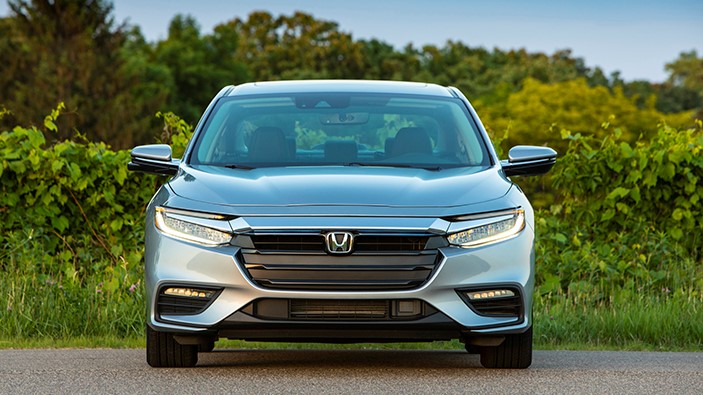This 2019 Honda Insight drove 550 miles without a fill. Here’s how

In a recent test of the 2019 Honda Insight, the third-gen hybrid that looks a bit like a Honda Civic, it was obvious that the electric motor had been fine-tuned to help you merge into traffic.
It worked in conjunction with the gas engine for a combined MPG of 55-miles-to-the-gallon, and in practice, meant we drove the Insight for a full 550 miles before needing to do a fill. We had to check the range and the miles a couple of times, because that type of range is usually reserved for small, slightly obnoxious hybrids like the Toyota Prius. What’s actually happening?
Expert power management
Honda has engineered a hybrid system that uses a 60-cell lithium ion battery pack. You can watch all of this on the eight-inch touchscreen, which shows how the Insight expertly manages the power. On a long drive in a remote area, the Insight would switch to all electric every time we started going down even a slight incline, the drivetrain animated as a green line.
At low speeds, you can switch to an EV mode, although if you floor it you won’t stay in that mode for long. As you drive, the gas engine can also help recharge the battery, say when you start braking or on the descent when you don’t need to use a sip of fuel.
What seemed amazing about the Insight, though, was that this didn't lead to overly sluggish behavior, even if you switch between the Econ and Sport modes. The engine does tend to race, as you might experience in most hybrids, but up to about 30 or 40 MPH you can tell the electric motor is doing most of the work to give the Insight a more sprightly feel. On other hybrids, there might be an electric motor, but the car still tends to drive like a golf cart with a better stereo.



“The 2019 Insight utilizes the third-generation Honda two-motor hybrid system, which allows the system to operate in an EV Drive mode, Hybrid Drive mode, or Engine Drive mode and will switch seamlessly based on the needs of the driver,” says Chris Hand, the Honda Insight product planner.
“Under most circumstances, power to the wheels comes from the electric propulsion motor, which draws energy from the gasoline engine (which is connected to a generator motor) and/or battery pack. These options result in both better performance and efficiency depending on what the driver is looking for in that moment.”
Sign up for breaking news, reviews, opinion, top tech deals, and more.
Sleek and stylish
Also, those touchscreen views actually do help, because you can ease off the accelerator at times or coast in to a stop and watch as the display goes green. It’s almost entertaining, trying to increase your range and MPG in real-time.
Indeed, Honda states explicitly that the Sport mode draws more form the electric motor, and that’s a good trend - we’re not talking Tesla Model S sportiness here, but you won’t curse the day the automakers invented hybrids as much.


And you might not curse at the price, either. For $22,830 (about £18,000, AU$32,000), the Insight is a sleek and stylish sedan, with hints of both the Accord and the Civic, yet with enough range to make you happy you don’t have to visit the gas station as often. Which is another way of saying it doesn't look or drive at all like a hybrid.
The tech is the main reason to consider the Insight, though. You might not be able to fully explain the interchange between the gas engine and the electric motor, the extra power you can feel in Sport mode, or the long range. It won’t matter when you skip the pump.
On The Road is TechRadar's regular look at the futuristic tech in today's hottest cars. John Brandon, a journalist who's been writing about cars for 12 years, puts a new car and its cutting-edge tech through the paces every week. One goal: To find out which new technologies will lead us to fully driverless cars.

John Brandon has covered gadgets and cars for the past 12 years having published over 12,000 articles and tested nearly 8,000 products. He's nothing if not prolific. Before starting his writing career, he led an Information Design practice at a large consumer electronics retailer in the US. His hobbies include deep sea exploration, complaining about the weather, and engineering a vast multiverse conspiracy.